The Difference Between Lawn Damage from Bugs vs. Disease
Reading time: 6 - minutesBrown patches in your lawn? It could be bugs… or it could be a disease. The problem is, they often look the same at first.
Here’s how to tell the difference, and what to do next, so you don’t waste time (or money) on the wrong fix.
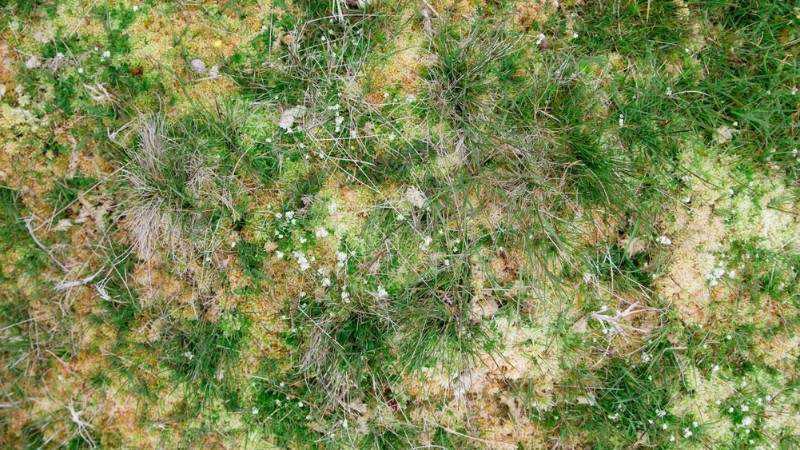
First Up: What Lawn Disease Looks Like
When we say “lawn disease,” we’re mostly talking about fungi. These are naturally present in your soil but only cause problems when your grass is already stressed. Here’s what to look for:
1. Weird fuzz in the morning dew
If you see what looks like white cobwebs or wisps on your grass first thing in the morning, and they disappear later in the day, you might be looking at dollar spot. It thrives in humid, wet conditions, and while the fuzz fades, the tan patches it leaves behind won’t.
Here’s what it looks like:
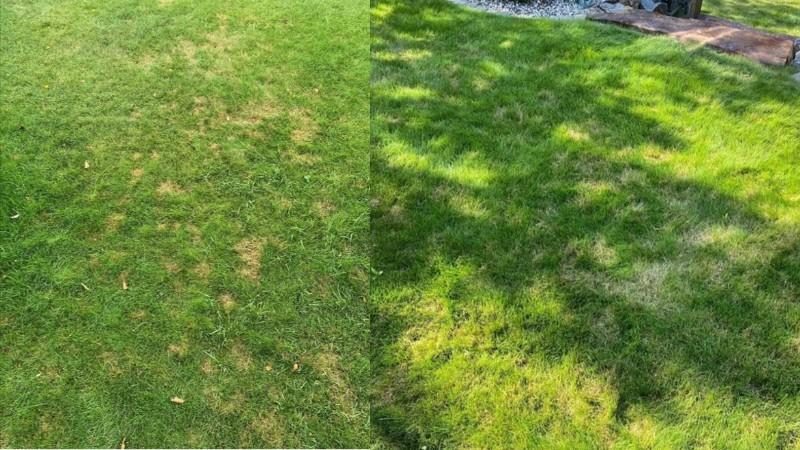
2. Red or pink threads
Some spots might have little pink or red fibres sticking up from tan-coloured grass. That’s red thread, another fungal disease. It’s more of a cosmetic problem, but it’s still a sign your lawn needs help (usually more nitrogen and better watering habits).
Here’s what it looks like:
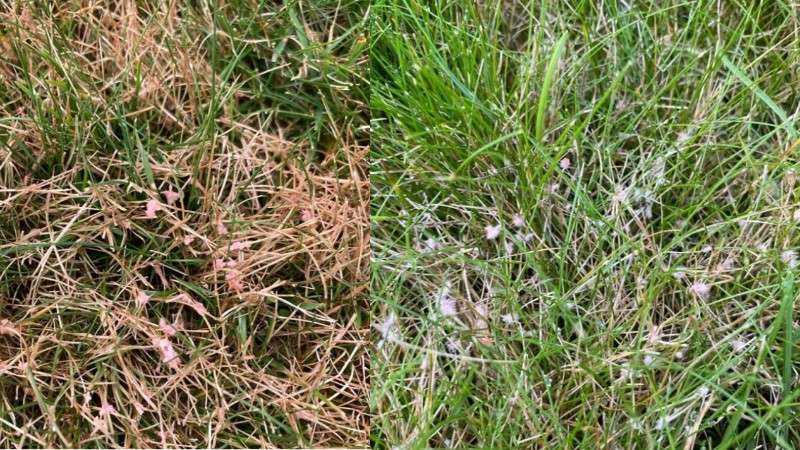
3. Matted, crusty circles after the snow melts
If your lawn looks like it has flattened, crusty patches with a gay or pinkish tone after the snow melts, especially in spots where snow piled up, you’re seeing the aftermath of a snow mould takeover.
Here’s what it looks like:

4. Frog-eye patches
These are rings of dead grass with green centres, like a bullseye on your lawn. This is a hallmark of necrotic ring spot or summer patch. Both of these root-based fungal diseases show up during heat stress, especially in Kentucky bluegrass lawns.
5. Dead patches that don’t green up in spring
Sometimes, it’s not a fungus at all; it’s winter kill. This happens when grass is smothered under ice, packed snow, or freezing winds for too long. When spring arrives, you’ll see patches that stay brown and brittle while the rest of your lawn starts greening up. Unfortunately, winter kill is permanent in those spots, so you’ll need to rake out the dead grass and overseed to bring them back.
Here’s what it looks like:
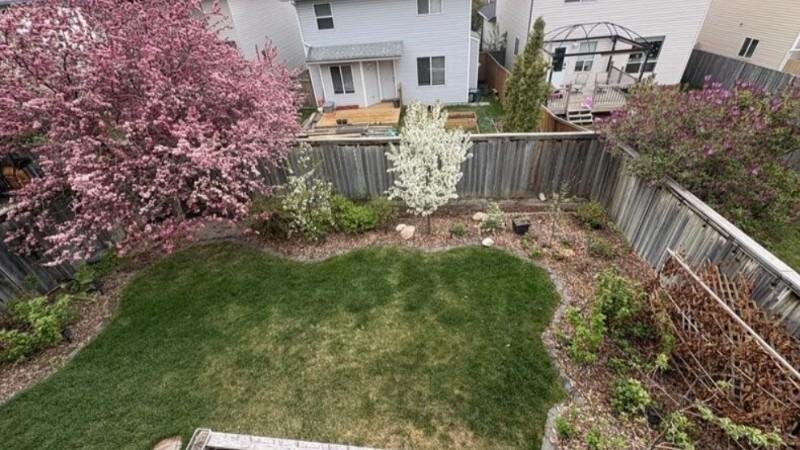
6. Big, smoky-looking circles in hot, humid weather
If you notice large brown or tan patches with a faint, smoky edge during warm, sticky weather, that’s likely brown patch disease. It’s caused by a fungus that loves heat and moisture. The patches can spread quickly, especially if you’ve been watering late in the evening or your lawn stays damp overnight.
Here’s what it looks like:
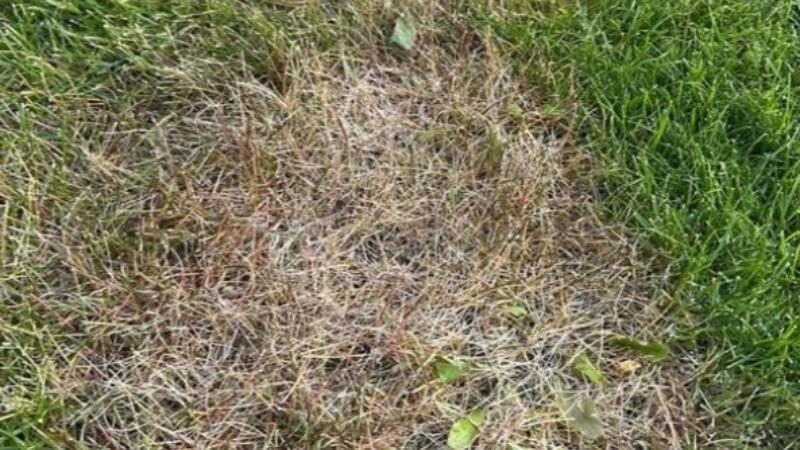
Now Let’s Talk About Bugs
If disease is a slow-burn problem, insects are the hit-and-run type culprits. Their damage often shows up more suddenly, and it’s usually tied to a specific lifecycle stage (like when grubs are actively feeding on roots or caterpillars are chewing leaves).
Here’s how to tell if you’ve got uninvited guests:
1. Sod that lifts like a rug
If you can grab a patch of brown grass and pull it up like loose carpet, that’s a strong sign of grubs. These C-shaped larvae of beetles (like Japanese beetles or June bugs) chew through the roots. Bonus tip: If raccoons or skunks are tearing up your yard, they’re likely going after grubs for a midnight snack.
2. Patches that don’t respond to watering
Chinch bug damage often looks like drought. The grass starts to yellow and turn brown, especially in hot, sunny areas. It doesn’t recover even if you water generously. If your lawn isn’t bouncing back the way it should, chinch bugs might be to blame.
Here’s what it looks like:

3. Chewed blades, thinning patches or moths flying up when you mow
If little tan moths flutter up while you’re mowing or walking through the grass, you could be dealing with sod webworms.
Another sign? Your lawn looks like it’s been grazed by tiny scissors. These are the larvae of a small moth that lays eggs in your grass. Once they hatch, the caterpillar-like worms chew on grass blades at night and hide in silky tunnels during the day. Damage usually starts as small brown patches that quickly spread, especially in sunny, dry areas.
Here’s what it looks like:
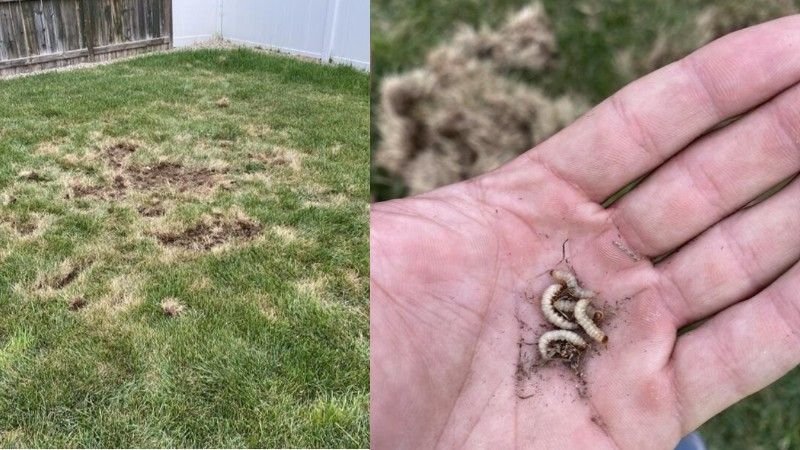
4. Stems that break at the crown
If dead stems break off at the base and feel hollow, you might have bluegrass billbugs. Look closely for dusting of sawdust-like frass (a.k.a. insect poop). Tugging gently at the crown will help confirm it.
Bug or Fungus? Here’s How to Tell the Difference
Not sure what you’re dealing with? There are simple ways to investigate before calling in the pros.
Try these:
- Tug test: Grab a handful of grass in the damaged area and pull gently. If it comes up easily, and you see grubs underneath or stems that are hollow, you're dealing with bugs.
- Soap flush test: Mix a tablespoon of dish soap into a gallon of water and pour it over a 2-ft. square patch. If insects are hiding in your thatch (like sod webworms or cutworms), they’ll come to the surface within a few minutes.
- Early morning fuzz check: Set your alarm a little earlier and head out at dawn. If you see white fuzz or threadlike growths that disappear as the sun comes up, chances are it’s a fungus.
Why It Matters: The Treatments Are Totally Different
This is where misdiagnosis gets expensive. Lawn disease and bug problems have completely different remedies.
Treating lawn disease usually involves:
- Adjusting your watering schedule. Fungus thrives on wet blades, especially overnight. Water early in the morning (before 6 a.m.), not at night.
- Improving air flow and drainage. Mowing too low or letting thatch build up can trap moisture. Aerating in the fall helps tremendously.
- Balanced fertilization. A lawn low in nitrogen is more susceptible to diseases like red thread or dollar spot.
- Fungicide (only when necessary). Not every disease needs chemical control. We only recommend fungicides for recurring or severe infections. And only the right product for the problem.
Insect problems, on the other hand, might require:
- Threshold monitoring. A few grubs are not usually a problem. A dozen per square foot means it’s time to act.
- Targeted insecticides. These must be applied at the right life stage, like after grub eggs hatch but before larvae dig deep.
- Spot treatment over blanket spraying. We want to protect the good bugs while controlling the bad ones.
- Fall lawn care recovery. If insects have thinned your turf, fall aeration and overseeding can help restore density and root strength fast.
Real Talk: Sometimes It’s Both
We wish it were always one or the other, but sometimes, it’s both. A stressed, thinning lawn is an open invitation to bugs and fungi alike. And throw in a heatwave or poor watering habits, and things go downhill fast.
If you’re starting to feel overwhelmed by brown patches, don’t panic. We can assess it quickly, explain what’s really going on, and help you tackle it step by step.
Here’s how Green Drop can help:
- We don’t guess. Our GreenKeepers do the same DIY tests we just shared with you, right on-site, to confirm exactly what’s going on.
- We focus on prevention. It’s not just about spraying a product. We’ll recommend adjustments to watering, mowing, and fertilizing that stop the problem from coming back.
- We prioritize your lawn’s long-term health. Whether you’ve got bugs or disease (or both) our plans are built to strengthen your turf, not just patch the surface.
- We know when to overseed, aerate, and mulch. Our lawn care packages are timed perfectly to restore lawns throughout the year, especially after winter and summer stress.
Patchy Lawn? Let’s Nip It in the Bud.
Whether you’re dealing with fungus, bugs, or just a fed-up lawn that’s had enough of this summer, we’ve got you. Our GreenKeepers can tell you exactly what’s going on, why it’s happening, and how to fix it fast.
No guessing, no over-spraying, and no “maybe try this” advice.
Let’s get your lawn back to green. Get a free estimate.

